A Comprehensive Report on ISO 9000 Certification and Business Impact
VerifiedAdded on 2023/01/10
|13
|2949
|62
Report
AI Summary
This report provides a comprehensive analysis of ISO 9000 certification, exploring the reasons behind its adoption and its impact on various business factors. The research investigates the relationship between ISO 9000 adoption and industry type, sales, profit, employee numbers, and foreign direct investment (FDI). Utilizing secondary research methodology and SPSS data analysis, the report examines descriptive and inferential statistics to test hypotheses and achieve research objectives. Key findings include the impact of industry on ISO 9000 certification, a positive correlation between certification and sales/profit, and differences in employee numbers between certified and non-certified companies. The study concludes that ISO 9000 certification is highly beneficial for businesses, particularly in attracting FDI and enhancing revenue generation, and recommends its adoption for improved quality management and business performance.

SPSS
Paraphrase This Document
Need a fresh take? Get an instant paraphrase of this document with our AI Paraphraser
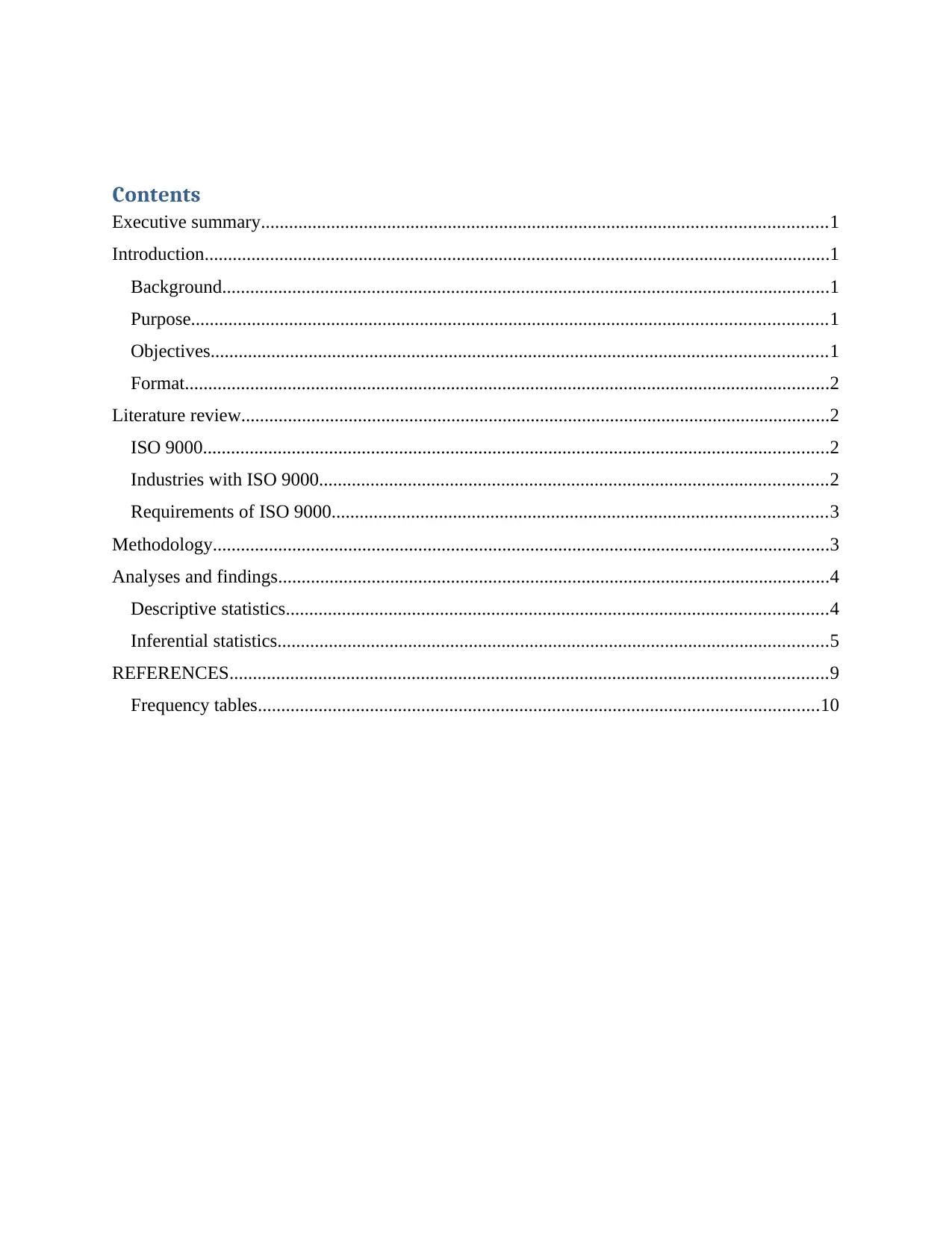
Contents
Executive summary.........................................................................................................................1
Introduction......................................................................................................................................1
Background..................................................................................................................................1
Purpose........................................................................................................................................1
Objectives....................................................................................................................................1
Format..........................................................................................................................................2
Literature review..............................................................................................................................2
ISO 9000......................................................................................................................................2
Industries with ISO 9000.............................................................................................................2
Requirements of ISO 9000..........................................................................................................3
Methodology....................................................................................................................................3
Analyses and findings......................................................................................................................4
Descriptive statistics....................................................................................................................4
Inferential statistics......................................................................................................................5
REFERENCES................................................................................................................................9
Frequency tables........................................................................................................................10
Executive summary.........................................................................................................................1
Introduction......................................................................................................................................1
Background..................................................................................................................................1
Purpose........................................................................................................................................1
Objectives....................................................................................................................................1
Format..........................................................................................................................................2
Literature review..............................................................................................................................2
ISO 9000......................................................................................................................................2
Industries with ISO 9000.............................................................................................................2
Requirements of ISO 9000..........................................................................................................3
Methodology....................................................................................................................................3
Analyses and findings......................................................................................................................4
Descriptive statistics....................................................................................................................4
Inferential statistics......................................................................................................................5
REFERENCES................................................................................................................................9
Frequency tables........................................................................................................................10

⊘ This is a preview!⊘
Do you want full access?
Subscribe today to unlock all pages.

Trusted by 1+ million students worldwide
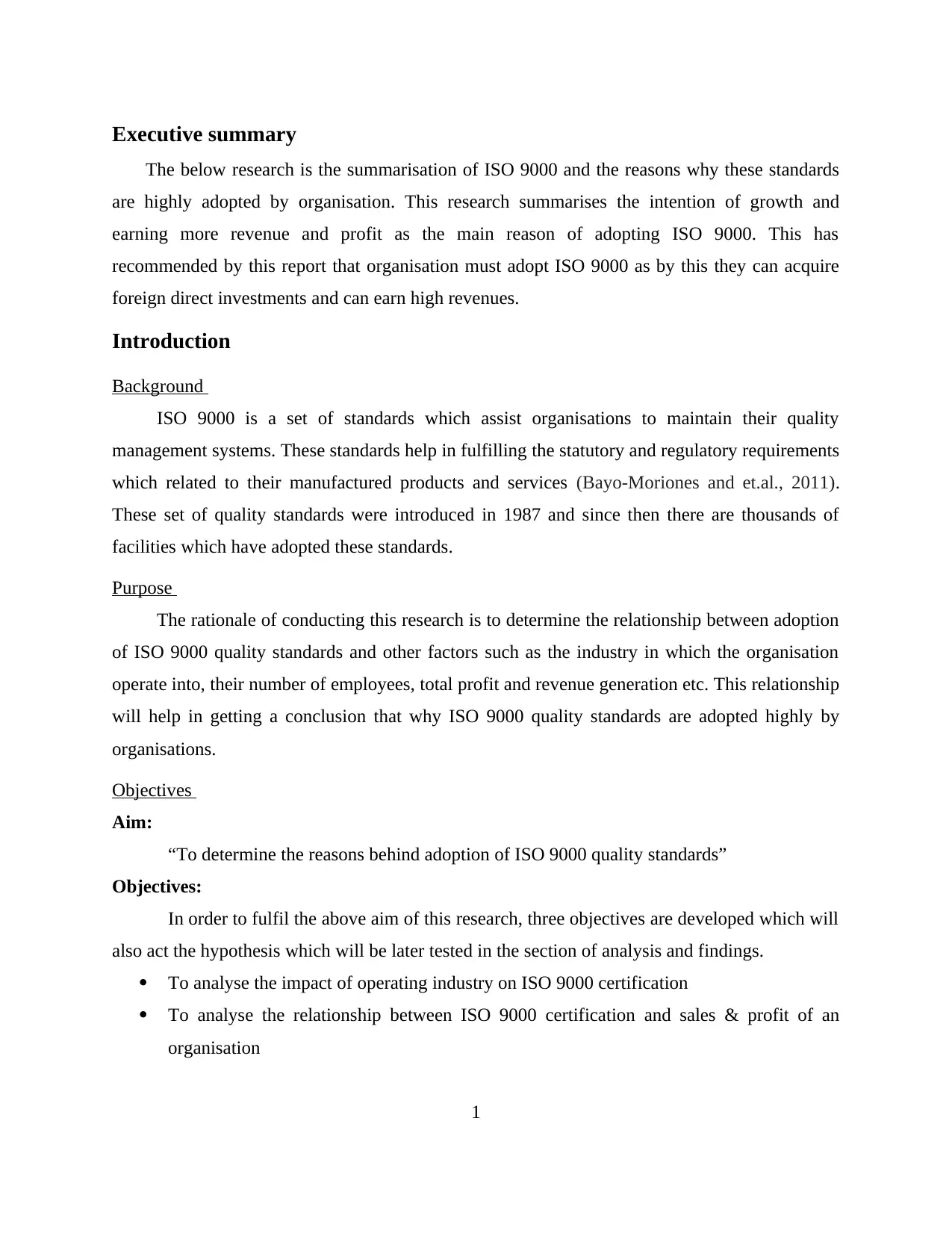
Executive summary
The below research is the summarisation of ISO 9000 and the reasons why these standards
are highly adopted by organisation. This research summarises the intention of growth and
earning more revenue and profit as the main reason of adopting ISO 9000. This has
recommended by this report that organisation must adopt ISO 9000 as by this they can acquire
foreign direct investments and can earn high revenues.
Introduction
Background
ISO 9000 is a set of standards which assist organisations to maintain their quality
management systems. These standards help in fulfilling the statutory and regulatory requirements
which related to their manufactured products and services (Bayo-Moriones and et.al., 2011).
These set of quality standards were introduced in 1987 and since then there are thousands of
facilities which have adopted these standards.
Purpose
The rationale of conducting this research is to determine the relationship between adoption
of ISO 9000 quality standards and other factors such as the industry in which the organisation
operate into, their number of employees, total profit and revenue generation etc. This relationship
will help in getting a conclusion that why ISO 9000 quality standards are adopted highly by
organisations.
Objectives
Aim:
“To determine the reasons behind adoption of ISO 9000 quality standards”
Objectives:
In order to fulfil the above aim of this research, three objectives are developed which will
also act the hypothesis which will be later tested in the section of analysis and findings.
To analyse the impact of operating industry on ISO 9000 certification
To analyse the relationship between ISO 9000 certification and sales & profit of an
organisation
1
The below research is the summarisation of ISO 9000 and the reasons why these standards
are highly adopted by organisation. This research summarises the intention of growth and
earning more revenue and profit as the main reason of adopting ISO 9000. This has
recommended by this report that organisation must adopt ISO 9000 as by this they can acquire
foreign direct investments and can earn high revenues.
Introduction
Background
ISO 9000 is a set of standards which assist organisations to maintain their quality
management systems. These standards help in fulfilling the statutory and regulatory requirements
which related to their manufactured products and services (Bayo-Moriones and et.al., 2011).
These set of quality standards were introduced in 1987 and since then there are thousands of
facilities which have adopted these standards.
Purpose
The rationale of conducting this research is to determine the relationship between adoption
of ISO 9000 quality standards and other factors such as the industry in which the organisation
operate into, their number of employees, total profit and revenue generation etc. This relationship
will help in getting a conclusion that why ISO 9000 quality standards are adopted highly by
organisations.
Objectives
Aim:
“To determine the reasons behind adoption of ISO 9000 quality standards”
Objectives:
In order to fulfil the above aim of this research, three objectives are developed which will
also act the hypothesis which will be later tested in the section of analysis and findings.
To analyse the impact of operating industry on ISO 9000 certification
To analyse the relationship between ISO 9000 certification and sales & profit of an
organisation
1
Paraphrase This Document
Need a fresh take? Get an instant paraphrase of this document with our AI Paraphraser
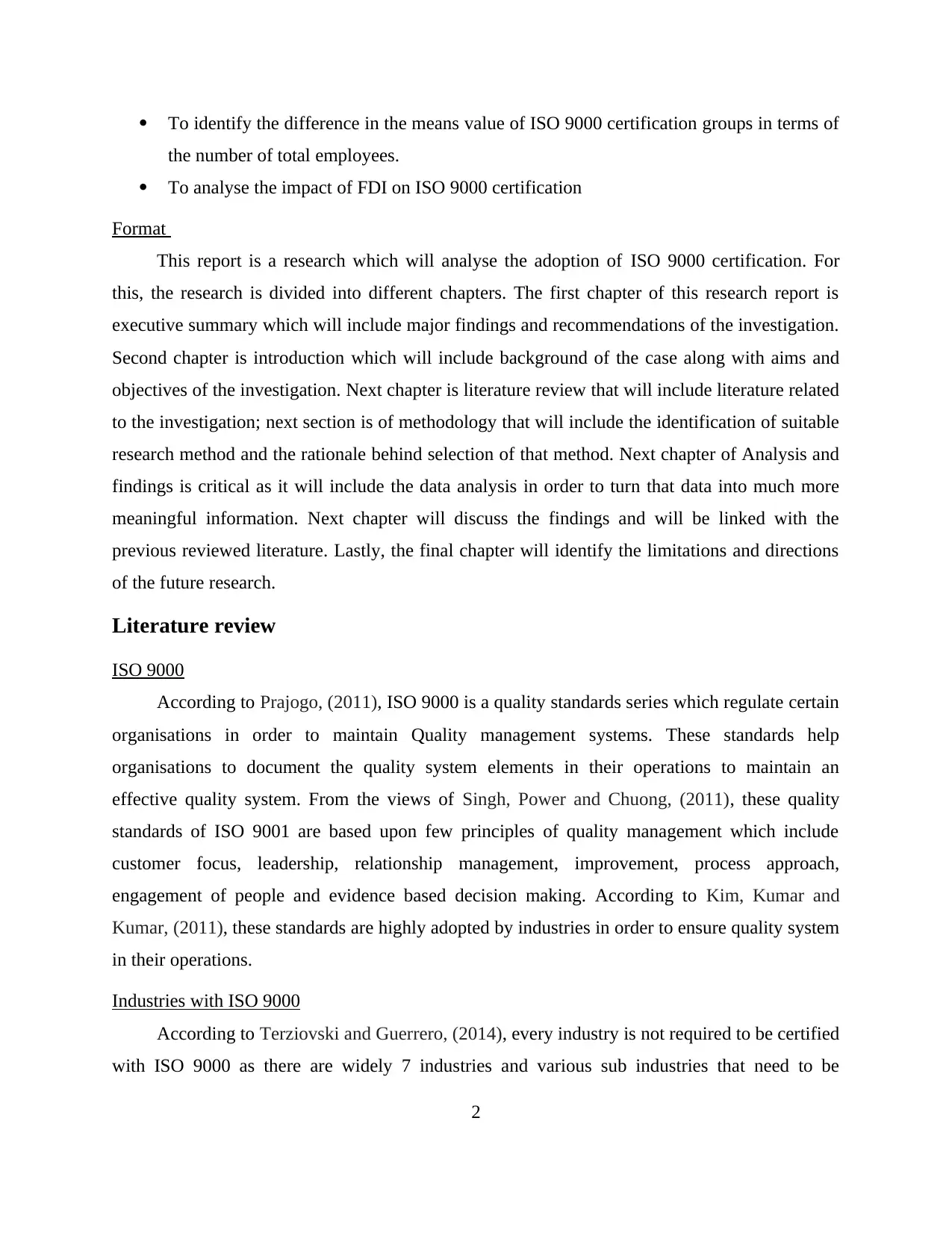
To identify the difference in the means value of ISO 9000 certification groups in terms of
the number of total employees.
To analyse the impact of FDI on ISO 9000 certification
Format
This report is a research which will analyse the adoption of ISO 9000 certification. For
this, the research is divided into different chapters. The first chapter of this research report is
executive summary which will include major findings and recommendations of the investigation.
Second chapter is introduction which will include background of the case along with aims and
objectives of the investigation. Next chapter is literature review that will include literature related
to the investigation; next section is of methodology that will include the identification of suitable
research method and the rationale behind selection of that method. Next chapter of Analysis and
findings is critical as it will include the data analysis in order to turn that data into much more
meaningful information. Next chapter will discuss the findings and will be linked with the
previous reviewed literature. Lastly, the final chapter will identify the limitations and directions
of the future research.
Literature review
ISO 9000
According to Prajogo, (2011), ISO 9000 is a quality standards series which regulate certain
organisations in order to maintain Quality management systems. These standards help
organisations to document the quality system elements in their operations to maintain an
effective quality system. From the views of Singh, Power and Chuong, (2011), these quality
standards of ISO 9001 are based upon few principles of quality management which include
customer focus, leadership, relationship management, improvement, process approach,
engagement of people and evidence based decision making. According to Kim, Kumar and
Kumar, (2011), these standards are highly adopted by industries in order to ensure quality system
in their operations.
Industries with ISO 9000
According to Terziovski and Guerrero, (2014), every industry is not required to be certified
with ISO 9000 as there are widely 7 industries and various sub industries that need to be
2
the number of total employees.
To analyse the impact of FDI on ISO 9000 certification
Format
This report is a research which will analyse the adoption of ISO 9000 certification. For
this, the research is divided into different chapters. The first chapter of this research report is
executive summary which will include major findings and recommendations of the investigation.
Second chapter is introduction which will include background of the case along with aims and
objectives of the investigation. Next chapter is literature review that will include literature related
to the investigation; next section is of methodology that will include the identification of suitable
research method and the rationale behind selection of that method. Next chapter of Analysis and
findings is critical as it will include the data analysis in order to turn that data into much more
meaningful information. Next chapter will discuss the findings and will be linked with the
previous reviewed literature. Lastly, the final chapter will identify the limitations and directions
of the future research.
Literature review
ISO 9000
According to Prajogo, (2011), ISO 9000 is a quality standards series which regulate certain
organisations in order to maintain Quality management systems. These standards help
organisations to document the quality system elements in their operations to maintain an
effective quality system. From the views of Singh, Power and Chuong, (2011), these quality
standards of ISO 9001 are based upon few principles of quality management which include
customer focus, leadership, relationship management, improvement, process approach,
engagement of people and evidence based decision making. According to Kim, Kumar and
Kumar, (2011), these standards are highly adopted by industries in order to ensure quality system
in their operations.
Industries with ISO 9000
According to Terziovski and Guerrero, (2014), every industry is not required to be certified
with ISO 9000 as there are widely 7 industries and various sub industries that need to be
2
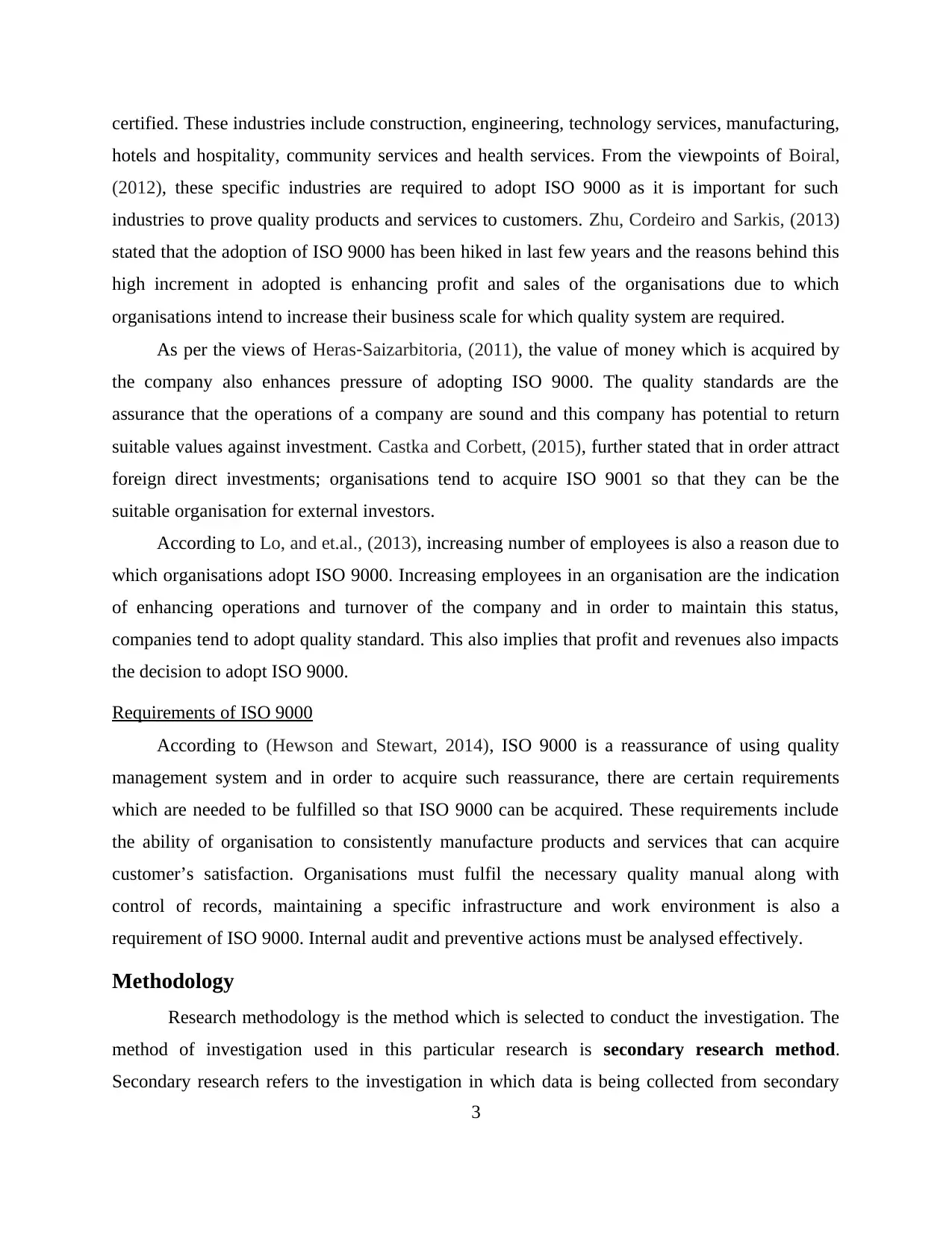
certified. These industries include construction, engineering, technology services, manufacturing,
hotels and hospitality, community services and health services. From the viewpoints of Boiral,
(2012), these specific industries are required to adopt ISO 9000 as it is important for such
industries to prove quality products and services to customers. Zhu, Cordeiro and Sarkis, (2013)
stated that the adoption of ISO 9000 has been hiked in last few years and the reasons behind this
high increment in adopted is enhancing profit and sales of the organisations due to which
organisations intend to increase their business scale for which quality system are required.
As per the views of Heras‐Saizarbitoria, (2011), the value of money which is acquired by
the company also enhances pressure of adopting ISO 9000. The quality standards are the
assurance that the operations of a company are sound and this company has potential to return
suitable values against investment. Castka and Corbett, (2015), further stated that in order attract
foreign direct investments; organisations tend to acquire ISO 9001 so that they can be the
suitable organisation for external investors.
According to Lo, and et.al., (2013), increasing number of employees is also a reason due to
which organisations adopt ISO 9000. Increasing employees in an organisation are the indication
of enhancing operations and turnover of the company and in order to maintain this status,
companies tend to adopt quality standard. This also implies that profit and revenues also impacts
the decision to adopt ISO 9000.
Requirements of ISO 9000
According to (Hewson and Stewart, 2014), ISO 9000 is a reassurance of using quality
management system and in order to acquire such reassurance, there are certain requirements
which are needed to be fulfilled so that ISO 9000 can be acquired. These requirements include
the ability of organisation to consistently manufacture products and services that can acquire
customer’s satisfaction. Organisations must fulfil the necessary quality manual along with
control of records, maintaining a specific infrastructure and work environment is also a
requirement of ISO 9000. Internal audit and preventive actions must be analysed effectively.
Methodology
Research methodology is the method which is selected to conduct the investigation. The
method of investigation used in this particular research is secondary research method.
Secondary research refers to the investigation in which data is being collected from secondary
3
hotels and hospitality, community services and health services. From the viewpoints of Boiral,
(2012), these specific industries are required to adopt ISO 9000 as it is important for such
industries to prove quality products and services to customers. Zhu, Cordeiro and Sarkis, (2013)
stated that the adoption of ISO 9000 has been hiked in last few years and the reasons behind this
high increment in adopted is enhancing profit and sales of the organisations due to which
organisations intend to increase their business scale for which quality system are required.
As per the views of Heras‐Saizarbitoria, (2011), the value of money which is acquired by
the company also enhances pressure of adopting ISO 9000. The quality standards are the
assurance that the operations of a company are sound and this company has potential to return
suitable values against investment. Castka and Corbett, (2015), further stated that in order attract
foreign direct investments; organisations tend to acquire ISO 9001 so that they can be the
suitable organisation for external investors.
According to Lo, and et.al., (2013), increasing number of employees is also a reason due to
which organisations adopt ISO 9000. Increasing employees in an organisation are the indication
of enhancing operations and turnover of the company and in order to maintain this status,
companies tend to adopt quality standard. This also implies that profit and revenues also impacts
the decision to adopt ISO 9000.
Requirements of ISO 9000
According to (Hewson and Stewart, 2014), ISO 9000 is a reassurance of using quality
management system and in order to acquire such reassurance, there are certain requirements
which are needed to be fulfilled so that ISO 9000 can be acquired. These requirements include
the ability of organisation to consistently manufacture products and services that can acquire
customer’s satisfaction. Organisations must fulfil the necessary quality manual along with
control of records, maintaining a specific infrastructure and work environment is also a
requirement of ISO 9000. Internal audit and preventive actions must be analysed effectively.
Methodology
Research methodology is the method which is selected to conduct the investigation. The
method of investigation used in this particular research is secondary research method.
Secondary research refers to the investigation in which data is being collected from secondary
3
⊘ This is a preview!⊘
Do you want full access?
Subscribe today to unlock all pages.

Trusted by 1+ million students worldwide
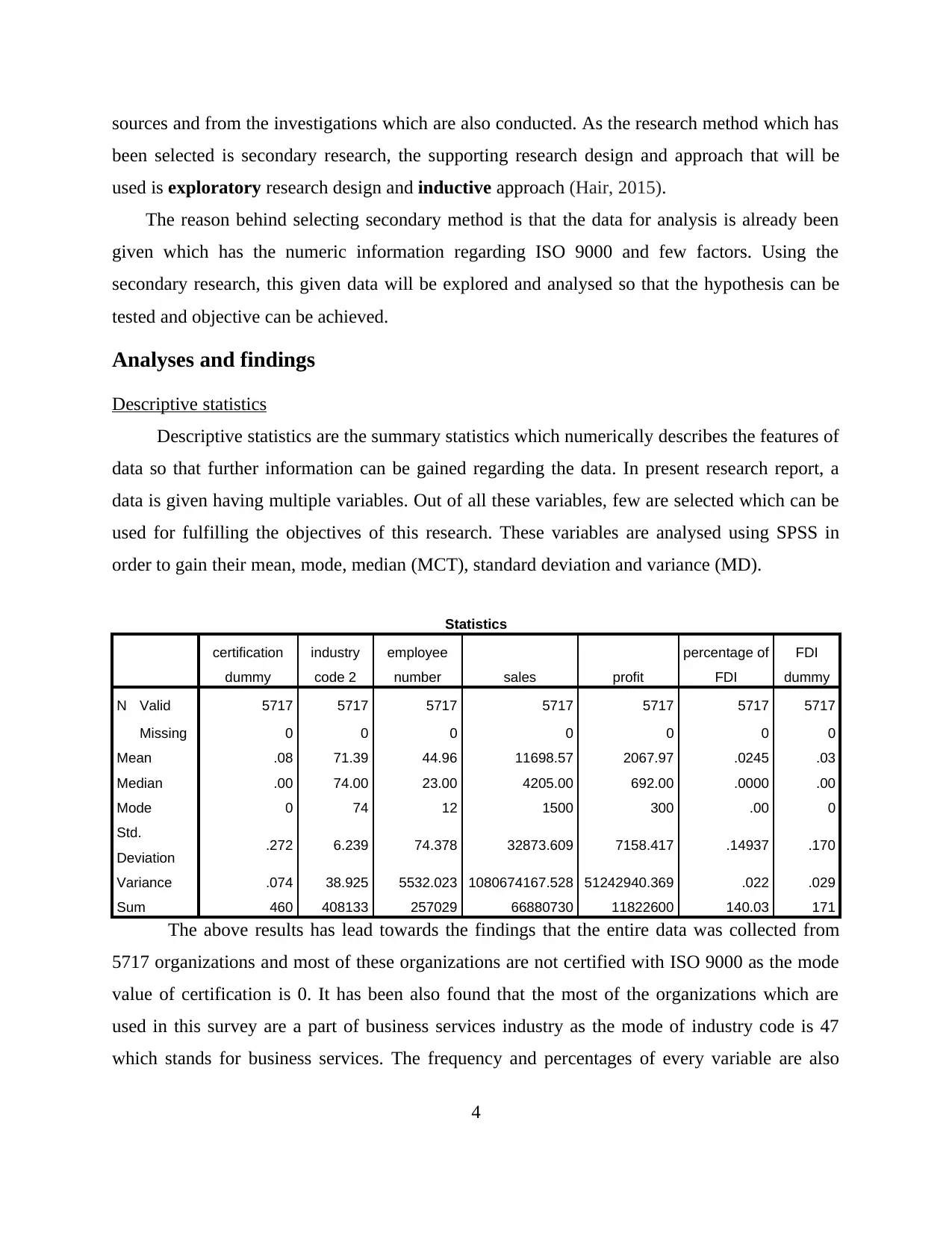
sources and from the investigations which are also conducted. As the research method which has
been selected is secondary research, the supporting research design and approach that will be
used is exploratory research design and inductive approach (Hair, 2015).
The reason behind selecting secondary method is that the data for analysis is already been
given which has the numeric information regarding ISO 9000 and few factors. Using the
secondary research, this given data will be explored and analysed so that the hypothesis can be
tested and objective can be achieved.
Analyses and findings
Descriptive statistics
Descriptive statistics are the summary statistics which numerically describes the features of
data so that further information can be gained regarding the data. In present research report, a
data is given having multiple variables. Out of all these variables, few are selected which can be
used for fulfilling the objectives of this research. These variables are analysed using SPSS in
order to gain their mean, mode, median (MCT), standard deviation and variance (MD).
Statistics
certification
dummy
industry
code 2
employee
number sales profit
percentage of
FDI
FDI
dummy
N Valid 5717 5717 5717 5717 5717 5717 5717
Missing 0 0 0 0 0 0 0
Mean .08 71.39 44.96 11698.57 2067.97 .0245 .03
Median .00 74.00 23.00 4205.00 692.00 .0000 .00
Mode 0 74 12 1500 300 .00 0
Std.
Deviation .272 6.239 74.378 32873.609 7158.417 .14937 .170
Variance .074 38.925 5532.023 1080674167.528 51242940.369 .022 .029
Sum 460 408133 257029 66880730 11822600 140.03 171
The above results has lead towards the findings that the entire data was collected from
5717 organizations and most of these organizations are not certified with ISO 9000 as the mode
value of certification is 0. It has been also found that the most of the organizations which are
used in this survey are a part of business services industry as the mode of industry code is 47
which stands for business services. The frequency and percentages of every variable are also
4
been selected is secondary research, the supporting research design and approach that will be
used is exploratory research design and inductive approach (Hair, 2015).
The reason behind selecting secondary method is that the data for analysis is already been
given which has the numeric information regarding ISO 9000 and few factors. Using the
secondary research, this given data will be explored and analysed so that the hypothesis can be
tested and objective can be achieved.
Analyses and findings
Descriptive statistics
Descriptive statistics are the summary statistics which numerically describes the features of
data so that further information can be gained regarding the data. In present research report, a
data is given having multiple variables. Out of all these variables, few are selected which can be
used for fulfilling the objectives of this research. These variables are analysed using SPSS in
order to gain their mean, mode, median (MCT), standard deviation and variance (MD).
Statistics
certification
dummy
industry
code 2
employee
number sales profit
percentage of
FDI
FDI
dummy
N Valid 5717 5717 5717 5717 5717 5717 5717
Missing 0 0 0 0 0 0 0
Mean .08 71.39 44.96 11698.57 2067.97 .0245 .03
Median .00 74.00 23.00 4205.00 692.00 .0000 .00
Mode 0 74 12 1500 300 .00 0
Std.
Deviation .272 6.239 74.378 32873.609 7158.417 .14937 .170
Variance .074 38.925 5532.023 1080674167.528 51242940.369 .022 .029
Sum 460 408133 257029 66880730 11822600 140.03 171
The above results has lead towards the findings that the entire data was collected from
5717 organizations and most of these organizations are not certified with ISO 9000 as the mode
value of certification is 0. It has been also found that the most of the organizations which are
used in this survey are a part of business services industry as the mode of industry code is 47
which stands for business services. The frequency and percentages of every variable are also
4
Paraphrase This Document
Need a fresh take? Get an instant paraphrase of this document with our AI Paraphraser
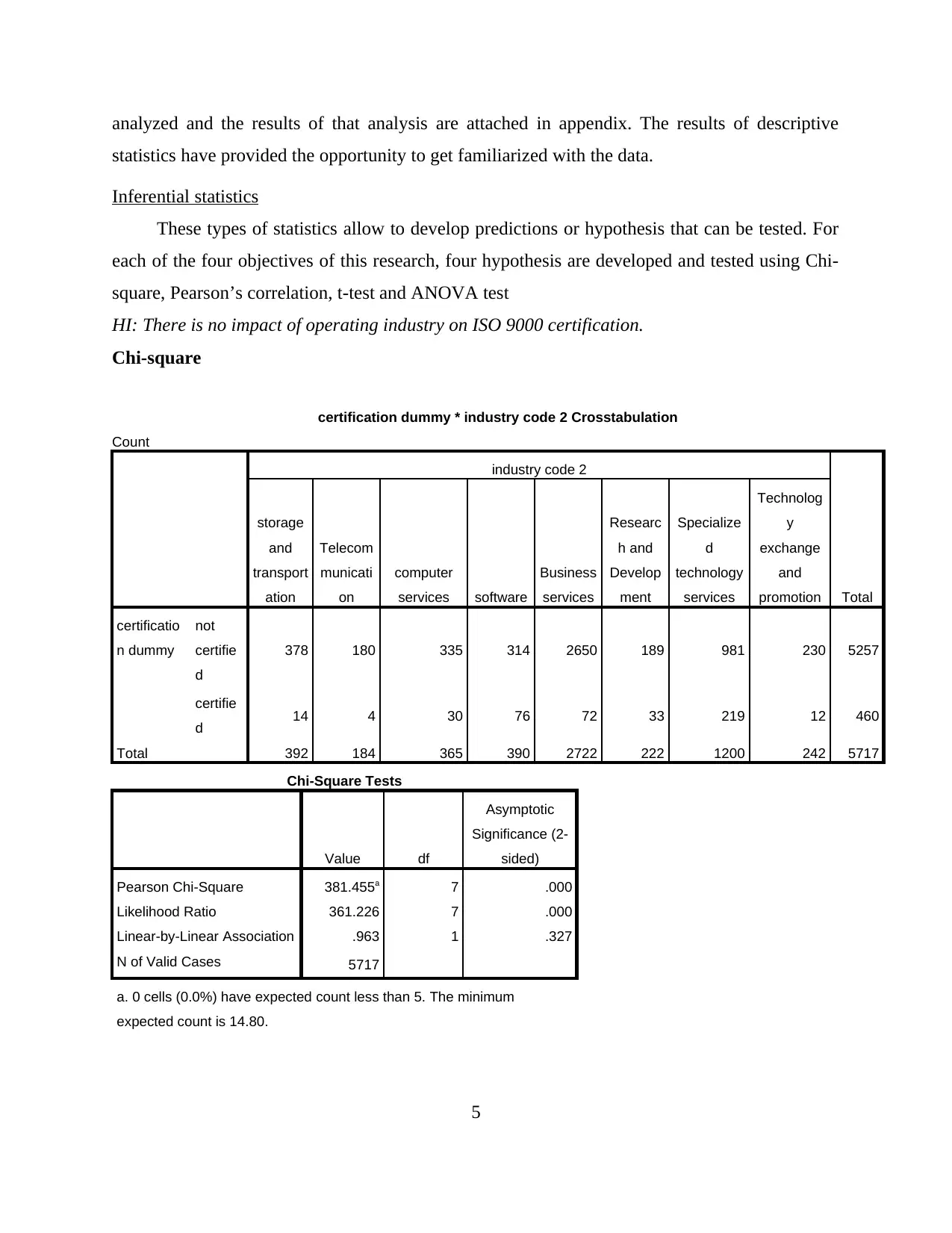
analyzed and the results of that analysis are attached in appendix. The results of descriptive
statistics have provided the opportunity to get familiarized with the data.
Inferential statistics
These types of statistics allow to develop predictions or hypothesis that can be tested. For
each of the four objectives of this research, four hypothesis are developed and tested using Chi-
square, Pearson’s correlation, t-test and ANOVA test
HI: There is no impact of operating industry on ISO 9000 certification.
Chi-square
certification dummy * industry code 2 Crosstabulation
Count
industry code 2
Total
storage
and
transport
ation
Telecom
municati
on
computer
services software
Business
services
Researc
h and
Develop
ment
Specialize
d
technology
services
Technolog
y
exchange
and
promotion
certificatio
n dummy
not
certifie
d
378 180 335 314 2650 189 981 230 5257
certifie
d 14 4 30 76 72 33 219 12 460
Total 392 184 365 390 2722 222 1200 242 5717
Chi-Square Tests
Value df
Asymptotic
Significance (2-
sided)
Pearson Chi-Square 381.455a 7 .000
Likelihood Ratio 361.226 7 .000
Linear-by-Linear Association .963 1 .327
N of Valid Cases 5717
a. 0 cells (0.0%) have expected count less than 5. The minimum
expected count is 14.80.
5
statistics have provided the opportunity to get familiarized with the data.
Inferential statistics
These types of statistics allow to develop predictions or hypothesis that can be tested. For
each of the four objectives of this research, four hypothesis are developed and tested using Chi-
square, Pearson’s correlation, t-test and ANOVA test
HI: There is no impact of operating industry on ISO 9000 certification.
Chi-square
certification dummy * industry code 2 Crosstabulation
Count
industry code 2
Total
storage
and
transport
ation
Telecom
municati
on
computer
services software
Business
services
Researc
h and
Develop
ment
Specialize
d
technology
services
Technolog
y
exchange
and
promotion
certificatio
n dummy
not
certifie
d
378 180 335 314 2650 189 981 230 5257
certifie
d 14 4 30 76 72 33 219 12 460
Total 392 184 365 390 2722 222 1200 242 5717
Chi-Square Tests
Value df
Asymptotic
Significance (2-
sided)
Pearson Chi-Square 381.455a 7 .000
Likelihood Ratio 361.226 7 .000
Linear-by-Linear Association .963 1 .327
N of Valid Cases 5717
a. 0 cells (0.0%) have expected count less than 5. The minimum
expected count is 14.80.
5
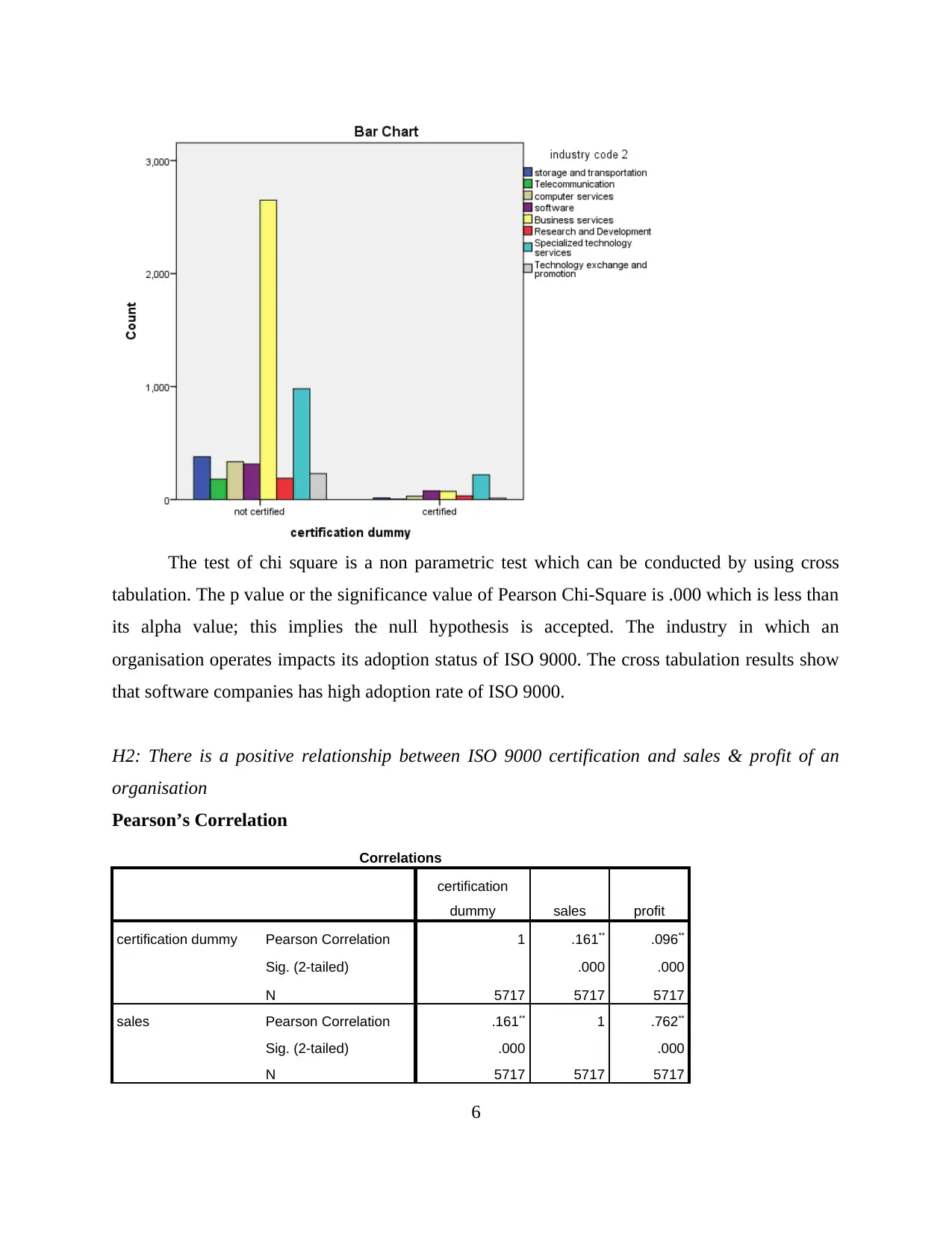
The test of chi square is a non parametric test which can be conducted by using cross
tabulation. The p value or the significance value of Pearson Chi-Square is .000 which is less than
its alpha value; this implies the null hypothesis is accepted. The industry in which an
organisation operates impacts its adoption status of ISO 9000. The cross tabulation results show
that software companies has high adoption rate of ISO 9000.
H2: There is a positive relationship between ISO 9000 certification and sales & profit of an
organisation
Pearson’s Correlation
Correlations
certification
dummy sales profit
certification dummy Pearson Correlation 1 .161** .096**
Sig. (2-tailed) .000 .000
N 5717 5717 5717
sales Pearson Correlation .161** 1 .762**
Sig. (2-tailed) .000 .000
N 5717 5717 5717
6
tabulation. The p value or the significance value of Pearson Chi-Square is .000 which is less than
its alpha value; this implies the null hypothesis is accepted. The industry in which an
organisation operates impacts its adoption status of ISO 9000. The cross tabulation results show
that software companies has high adoption rate of ISO 9000.
H2: There is a positive relationship between ISO 9000 certification and sales & profit of an
organisation
Pearson’s Correlation
Correlations
certification
dummy sales profit
certification dummy Pearson Correlation 1 .161** .096**
Sig. (2-tailed) .000 .000
N 5717 5717 5717
sales Pearson Correlation .161** 1 .762**
Sig. (2-tailed) .000 .000
N 5717 5717 5717
6
⊘ This is a preview!⊘
Do you want full access?
Subscribe today to unlock all pages.

Trusted by 1+ million students worldwide
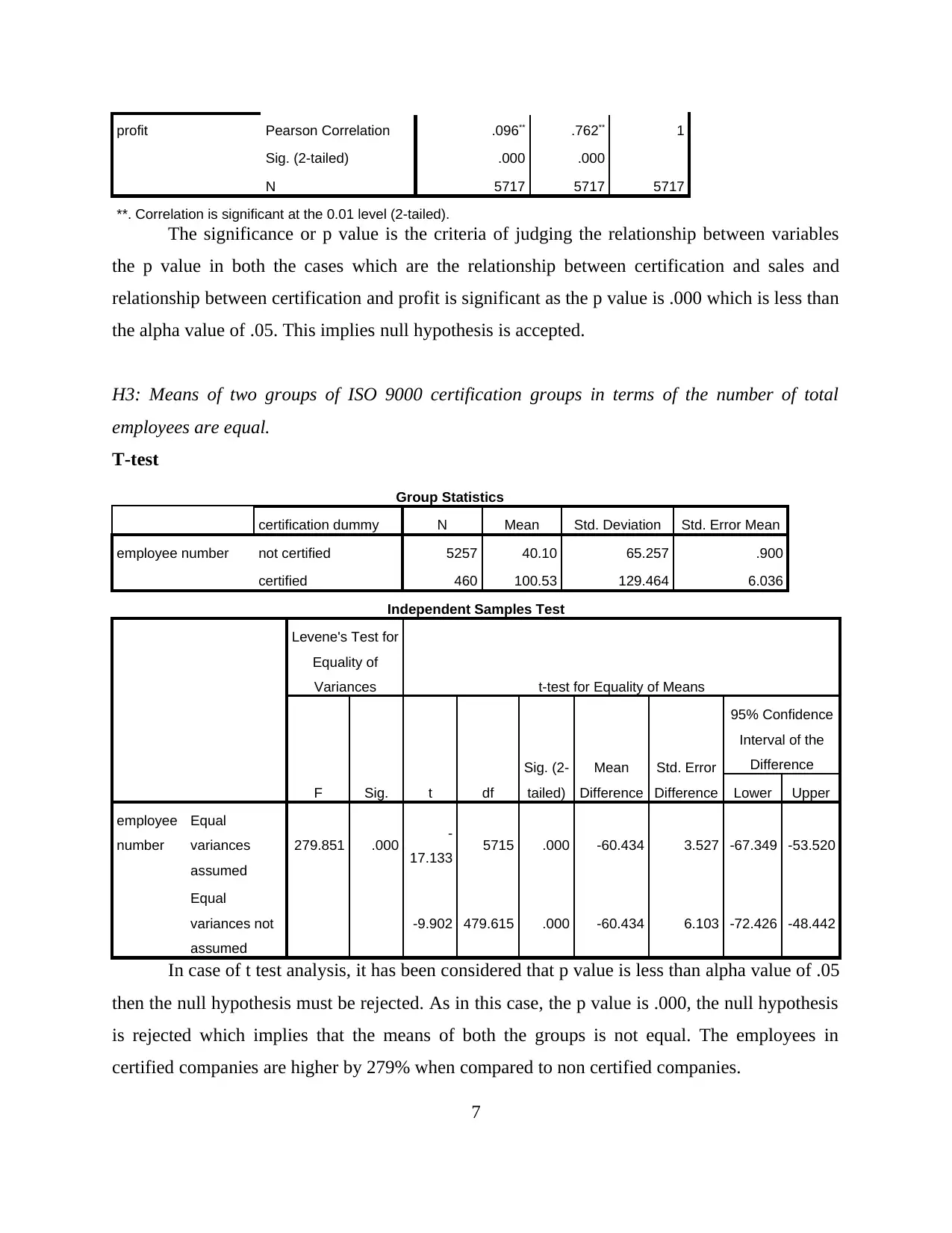
profit Pearson Correlation .096** .762** 1
Sig. (2-tailed) .000 .000
N 5717 5717 5717
**. Correlation is significant at the 0.01 level (2-tailed).
The significance or p value is the criteria of judging the relationship between variables
the p value in both the cases which are the relationship between certification and sales and
relationship between certification and profit is significant as the p value is .000 which is less than
the alpha value of .05. This implies null hypothesis is accepted.
H3: Means of two groups of ISO 9000 certification groups in terms of the number of total
employees are equal.
T-test
Group Statistics
certification dummy N Mean Std. Deviation Std. Error Mean
employee number not certified 5257 40.10 65.257 .900
certified 460 100.53 129.464 6.036
Independent Samples Test
Levene's Test for
Equality of
Variances t-test for Equality of Means
F Sig. t df
Sig. (2-
tailed)
Mean
Difference
Std. Error
Difference
95% Confidence
Interval of the
Difference
Lower Upper
employee
number
Equal
variances
assumed
279.851 .000 -
17.133 5715 .000 -60.434 3.527 -67.349 -53.520
Equal
variances not
assumed
-9.902 479.615 .000 -60.434 6.103 -72.426 -48.442
In case of t test analysis, it has been considered that p value is less than alpha value of .05
then the null hypothesis must be rejected. As in this case, the p value is .000, the null hypothesis
is rejected which implies that the means of both the groups is not equal. The employees in
certified companies are higher by 279% when compared to non certified companies.
7
Sig. (2-tailed) .000 .000
N 5717 5717 5717
**. Correlation is significant at the 0.01 level (2-tailed).
The significance or p value is the criteria of judging the relationship between variables
the p value in both the cases which are the relationship between certification and sales and
relationship between certification and profit is significant as the p value is .000 which is less than
the alpha value of .05. This implies null hypothesis is accepted.
H3: Means of two groups of ISO 9000 certification groups in terms of the number of total
employees are equal.
T-test
Group Statistics
certification dummy N Mean Std. Deviation Std. Error Mean
employee number not certified 5257 40.10 65.257 .900
certified 460 100.53 129.464 6.036
Independent Samples Test
Levene's Test for
Equality of
Variances t-test for Equality of Means
F Sig. t df
Sig. (2-
tailed)
Mean
Difference
Std. Error
Difference
95% Confidence
Interval of the
Difference
Lower Upper
employee
number
Equal
variances
assumed
279.851 .000 -
17.133 5715 .000 -60.434 3.527 -67.349 -53.520
Equal
variances not
assumed
-9.902 479.615 .000 -60.434 6.103 -72.426 -48.442
In case of t test analysis, it has been considered that p value is less than alpha value of .05
then the null hypothesis must be rejected. As in this case, the p value is .000, the null hypothesis
is rejected which implies that the means of both the groups is not equal. The employees in
certified companies are higher by 279% when compared to non certified companies.
7
Paraphrase This Document
Need a fresh take? Get an instant paraphrase of this document with our AI Paraphraser
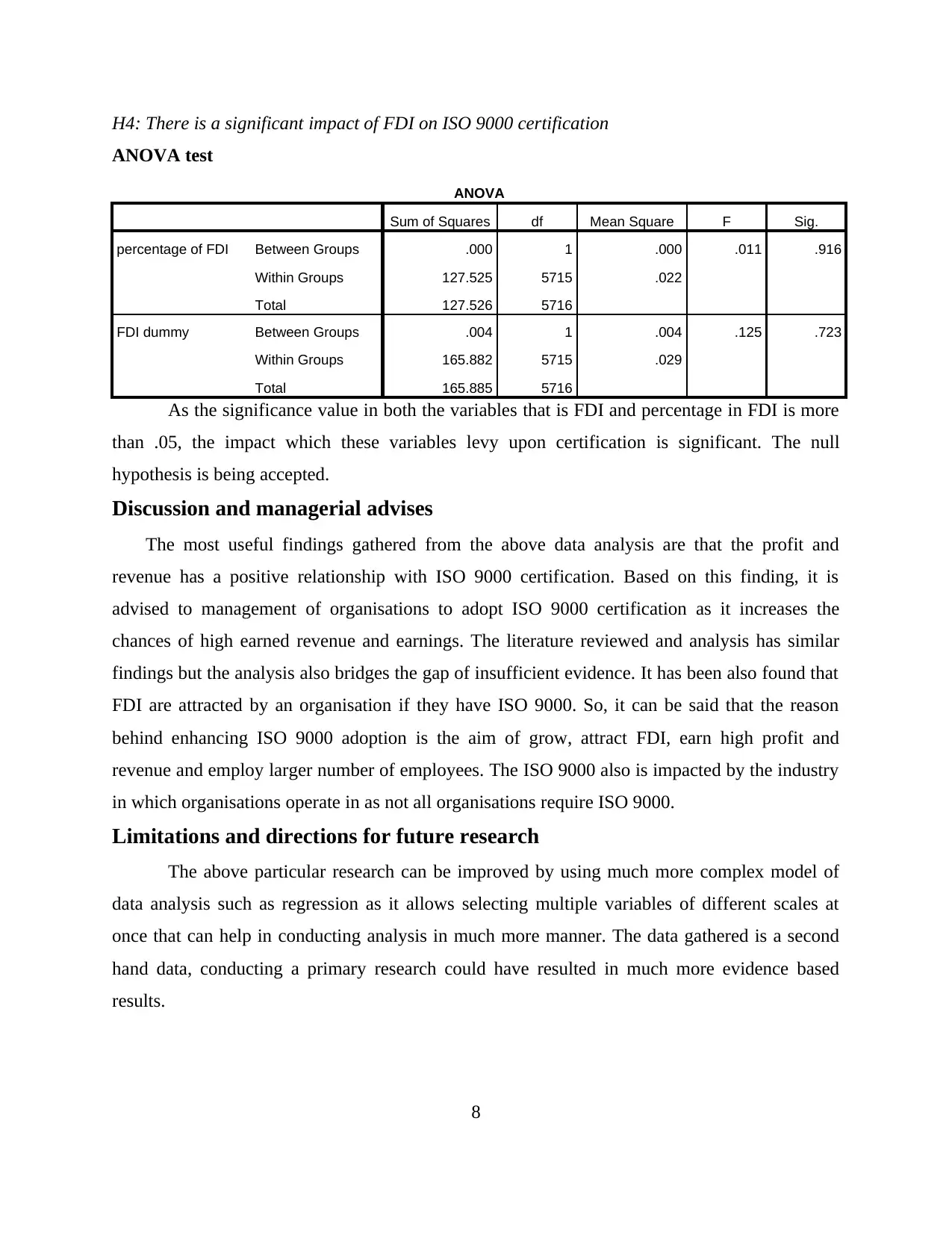
H4: There is a significant impact of FDI on ISO 9000 certification
ANOVA test
ANOVA
Sum of Squares df Mean Square F Sig.
percentage of FDI Between Groups .000 1 .000 .011 .916
Within Groups 127.525 5715 .022
Total 127.526 5716
FDI dummy Between Groups .004 1 .004 .125 .723
Within Groups 165.882 5715 .029
Total 165.885 5716
As the significance value in both the variables that is FDI and percentage in FDI is more
than .05, the impact which these variables levy upon certification is significant. The null
hypothesis is being accepted.
Discussion and managerial advises
The most useful findings gathered from the above data analysis are that the profit and
revenue has a positive relationship with ISO 9000 certification. Based on this finding, it is
advised to management of organisations to adopt ISO 9000 certification as it increases the
chances of high earned revenue and earnings. The literature reviewed and analysis has similar
findings but the analysis also bridges the gap of insufficient evidence. It has been also found that
FDI are attracted by an organisation if they have ISO 9000. So, it can be said that the reason
behind enhancing ISO 9000 adoption is the aim of grow, attract FDI, earn high profit and
revenue and employ larger number of employees. The ISO 9000 also is impacted by the industry
in which organisations operate in as not all organisations require ISO 9000.
Limitations and directions for future research
The above particular research can be improved by using much more complex model of
data analysis such as regression as it allows selecting multiple variables of different scales at
once that can help in conducting analysis in much more manner. The data gathered is a second
hand data, conducting a primary research could have resulted in much more evidence based
results.
8
ANOVA test
ANOVA
Sum of Squares df Mean Square F Sig.
percentage of FDI Between Groups .000 1 .000 .011 .916
Within Groups 127.525 5715 .022
Total 127.526 5716
FDI dummy Between Groups .004 1 .004 .125 .723
Within Groups 165.882 5715 .029
Total 165.885 5716
As the significance value in both the variables that is FDI and percentage in FDI is more
than .05, the impact which these variables levy upon certification is significant. The null
hypothesis is being accepted.
Discussion and managerial advises
The most useful findings gathered from the above data analysis are that the profit and
revenue has a positive relationship with ISO 9000 certification. Based on this finding, it is
advised to management of organisations to adopt ISO 9000 certification as it increases the
chances of high earned revenue and earnings. The literature reviewed and analysis has similar
findings but the analysis also bridges the gap of insufficient evidence. It has been also found that
FDI are attracted by an organisation if they have ISO 9000. So, it can be said that the reason
behind enhancing ISO 9000 adoption is the aim of grow, attract FDI, earn high profit and
revenue and employ larger number of employees. The ISO 9000 also is impacted by the industry
in which organisations operate in as not all organisations require ISO 9000.
Limitations and directions for future research
The above particular research can be improved by using much more complex model of
data analysis such as regression as it allows selecting multiple variables of different scales at
once that can help in conducting analysis in much more manner. The data gathered is a second
hand data, conducting a primary research could have resulted in much more evidence based
results.
8
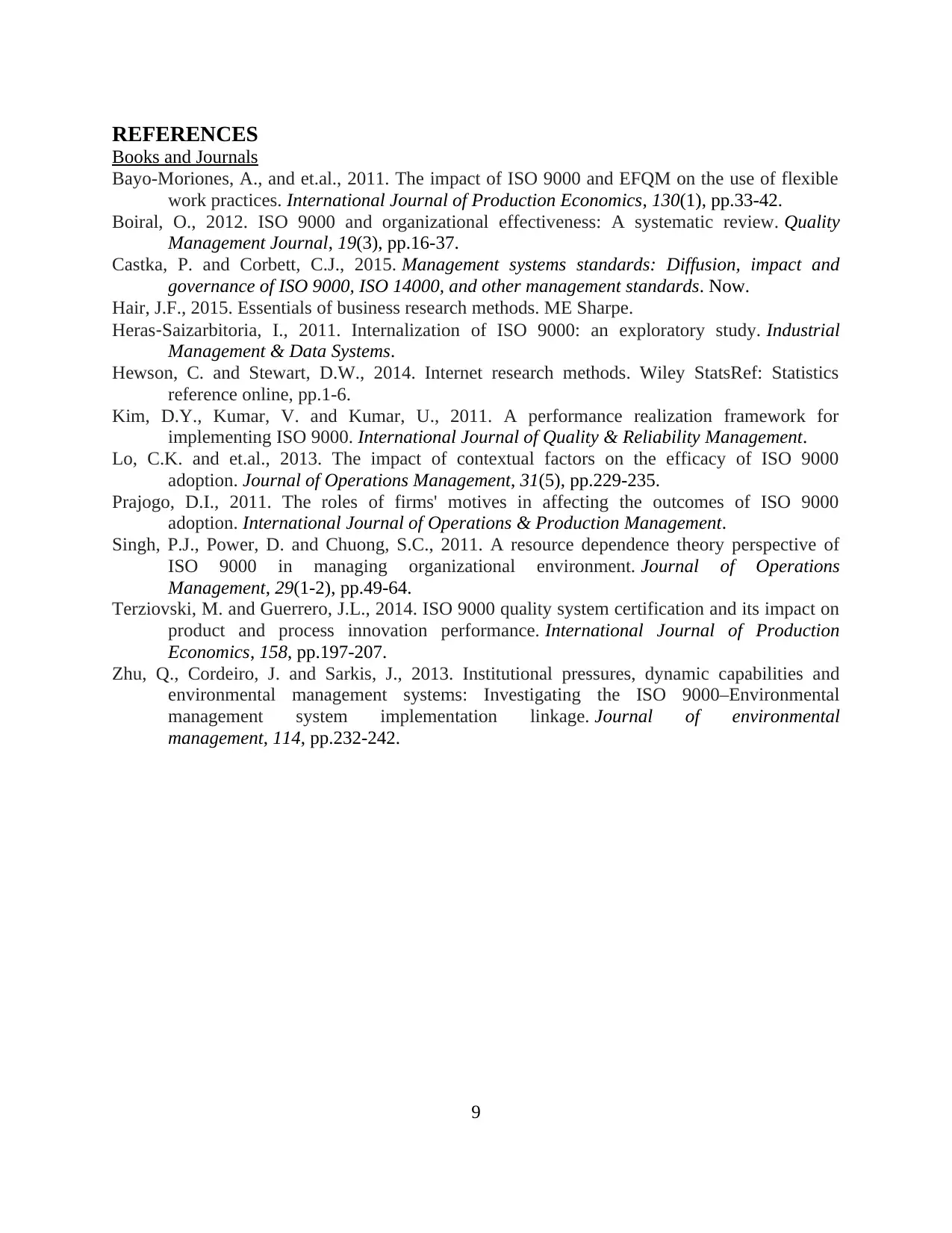
REFERENCES
Books and Journals
Bayo-Moriones, A., and et.al., 2011. The impact of ISO 9000 and EFQM on the use of flexible
work practices. International Journal of Production Economics, 130(1), pp.33-42.
Boiral, O., 2012. ISO 9000 and organizational effectiveness: A systematic review. Quality
Management Journal, 19(3), pp.16-37.
Castka, P. and Corbett, C.J., 2015. Management systems standards: Diffusion, impact and
governance of ISO 9000, ISO 14000, and other management standards. Now.
Hair, J.F., 2015. Essentials of business research methods. ME Sharpe.
Heras‐Saizarbitoria, I., 2011. Internalization of ISO 9000: an exploratory study. Industrial
Management & Data Systems.
Hewson, C. and Stewart, D.W., 2014. Internet research methods. Wiley StatsRef: Statistics
reference online, pp.1-6.
Kim, D.Y., Kumar, V. and Kumar, U., 2011. A performance realization framework for
implementing ISO 9000. International Journal of Quality & Reliability Management.
Lo, C.K. and et.al., 2013. The impact of contextual factors on the efficacy of ISO 9000
adoption. Journal of Operations Management, 31(5), pp.229-235.
Prajogo, D.I., 2011. The roles of firms' motives in affecting the outcomes of ISO 9000
adoption. International Journal of Operations & Production Management.
Singh, P.J., Power, D. and Chuong, S.C., 2011. A resource dependence theory perspective of
ISO 9000 in managing organizational environment. Journal of Operations
Management, 29(1-2), pp.49-64.
Terziovski, M. and Guerrero, J.L., 2014. ISO 9000 quality system certification and its impact on
product and process innovation performance. International Journal of Production
Economics, 158, pp.197-207.
Zhu, Q., Cordeiro, J. and Sarkis, J., 2013. Institutional pressures, dynamic capabilities and
environmental management systems: Investigating the ISO 9000–Environmental
management system implementation linkage. Journal of environmental
management, 114, pp.232-242.
9
Books and Journals
Bayo-Moriones, A., and et.al., 2011. The impact of ISO 9000 and EFQM on the use of flexible
work practices. International Journal of Production Economics, 130(1), pp.33-42.
Boiral, O., 2012. ISO 9000 and organizational effectiveness: A systematic review. Quality
Management Journal, 19(3), pp.16-37.
Castka, P. and Corbett, C.J., 2015. Management systems standards: Diffusion, impact and
governance of ISO 9000, ISO 14000, and other management standards. Now.
Hair, J.F., 2015. Essentials of business research methods. ME Sharpe.
Heras‐Saizarbitoria, I., 2011. Internalization of ISO 9000: an exploratory study. Industrial
Management & Data Systems.
Hewson, C. and Stewart, D.W., 2014. Internet research methods. Wiley StatsRef: Statistics
reference online, pp.1-6.
Kim, D.Y., Kumar, V. and Kumar, U., 2011. A performance realization framework for
implementing ISO 9000. International Journal of Quality & Reliability Management.
Lo, C.K. and et.al., 2013. The impact of contextual factors on the efficacy of ISO 9000
adoption. Journal of Operations Management, 31(5), pp.229-235.
Prajogo, D.I., 2011. The roles of firms' motives in affecting the outcomes of ISO 9000
adoption. International Journal of Operations & Production Management.
Singh, P.J., Power, D. and Chuong, S.C., 2011. A resource dependence theory perspective of
ISO 9000 in managing organizational environment. Journal of Operations
Management, 29(1-2), pp.49-64.
Terziovski, M. and Guerrero, J.L., 2014. ISO 9000 quality system certification and its impact on
product and process innovation performance. International Journal of Production
Economics, 158, pp.197-207.
Zhu, Q., Cordeiro, J. and Sarkis, J., 2013. Institutional pressures, dynamic capabilities and
environmental management systems: Investigating the ISO 9000–Environmental
management system implementation linkage. Journal of environmental
management, 114, pp.232-242.
9
⊘ This is a preview!⊘
Do you want full access?
Subscribe today to unlock all pages.

Trusted by 1+ million students worldwide
1 out of 13
Related Documents
Your All-in-One AI-Powered Toolkit for Academic Success.
+13062052269
info@desklib.com
Available 24*7 on WhatsApp / Email
![[object Object]](/_next/static/media/star-bottom.7253800d.svg)
Unlock your academic potential
Copyright © 2020–2025 A2Z Services. All Rights Reserved. Developed and managed by ZUCOL.





